|
FAQs about Non-Vertebrate Animal Identification
67
Related Articles: Marine Invertebrates, Marine Invertebrate Systems, Marine Invertebrate Compatibility,
Marine Invertebrate Disease,
Marine Invertebrate
Reproduction, Quarantine of Corals and
Invertebrates, Feeding
Reef Invertebrates, Lighting
Marine Invertebrates,
Water
Flow, How Much is Enough,
Related FAQs: Non-Vert IDs 1, Non-Vert IDs 2, Non-Vert IDs 3, Non-Vert IDs 4, Non-Vert IDs 5, Non-Vert IDs 6, Non-Vert IDs 7, Non-Vert IDs 8, Non-Vert IDs 9, Non-Vert IDs 10, Non-Vert IDs 11, Non-Vert IDs 12, Non-Vert IDs 13, Non-Vert IDs 14, Non-Vert IDs 15, Non-Vert IDs 16, Non-Vert IDs 17, Non-Vert IDs 18, Non-Vert. ID 19, Non-Vert. ID 20, Non-Vert. ID 21, Non-Vert. ID 22, Non-Vert. ID 23, Non-Vert. ID 25, Non-Vert ID 26, Non-Vert ID 27, Non-Vert ID 28, Non-Vert ID 29, Non-Vert ID 30, Non-Vert ID 31, Non-Vert ID 32, Non-Vert 33, Non-Vert ID 34 Non-Vert ID 35, Non-Vert ID 36, Non-Vert ID 37, Non-Vert ID 38, Non-Vert ID 39, Non-Vert ID 40, Non-Vert ID 41, Non-Vert ID 42, Non-Vert ID 43, Non-Vert ID 44, Non-Vert ID 45, Non-Vert ID 46, Non-Vert ID 47, Non-Vert ID 48, Non-Vert ID 49, Non-Vert ID 50, Non-Vert ID 51, Non-Vert ID 52, Non-Vert ID 53, Non-Vert ID 54, Non-Vert ID 55,
Non-Vert ID 56, Non-Vert ID
57, Non-Vert ID 58,
Non-Vert ID 59,
Non-Vert ID 60,
Non-Vert ID 61,
Non-Vert ID 62, Non-Vert ID 63,
Non-Vert ID 64,
Non-Vert ID 65,
Non-Vert ID 66,
Non-Vert ID 68,
Non-Vert ID 69,
& Marine Invertebrates,
Marine Invert.s 2,
Marine Invert.s 3, & FAQs about:
Marine Invertebrate Behavior,
Marine Invertebrate
Compatibility, Marine
Invertebrate Selection, Marine
Invertebrate Systems, Feeding
Reef Invertebrates, Marine
Invertebrate Disease, Marine
Invertebrate Reproduction, &
& LR
Life Identification, LR Hitchhiker ID
1, Anemone Identification,
Aiptasia
Identification, Aiptasia ID 2,
Worm Identification, Tubeworm ID, Polychaete Identification, Snail Identification, Marine Crab
Identification, Marine Invert.s 1,
Marine Invert.s 2, Marine Plankton,
|
|
|
Jawfish, Shrimp/Goby Pairs, and Picture ID
1/25/19
Good Morning Bob,
Please see attached photos but I was wondering if the sand in the tank was too
coarse for either a shrimp/goby pair or for Jawfish.
<It is not too coarse. Should work fine w/ the rubble et al. here>
The sand is fine overall but with a lot of rubble and broken sea shells.
Also one of the pictures has some type of tiny shrimp I was hoping you could
help identify.
<Not from this pic, no>
Kind of looks like a tiny Mantis shrimp and there are three of them in the tank.
<Do keep your eyes open... IF you're starting to miss other livestock, trapping
may be in order... (See WWM), or at the worst, systematically dismantling your
rock work, tank to remove them... IF they are Stomatopods; start causing
trouble.>
In the picture of the sand I was wondering if you knew what those black stick
things are on the right side of the picture. They are hollow and looks like some
type of tube.
<Yes; appear to be some type/species of Featherduster, tubeworm>
The green algae on the left is in one of those tubes. Do you know of any type of
organism from the Gulf of Mexico that would have green tentacles like that as I
assume it's some type of algae growing from the tube?
<Looks to be a Green... perhaps a Chlorodesmis species... hopefully
controllable... not Derbesia or... Bryopsis>
Thanks for taking the time to answer and hope you have a great day. P.S. Are you
going to be at Reef Palooza in Orlando this year, I believe it's sometime in
April? Jason
<Don't know; but I would. I thought the folks were going to ask me to speak
there last year.
Cheers, Bob Fenner>
|
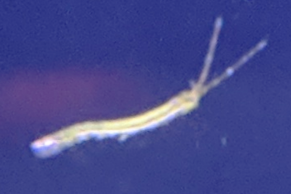
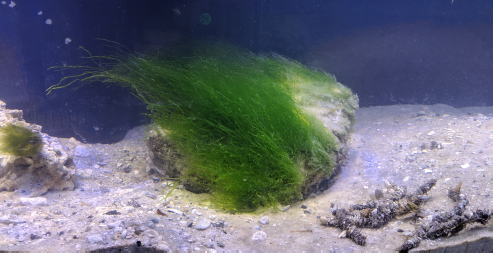 |
|
What is this? 12/16/18
Hi Crew!
<Blue...>
You guys are my “go to” peeps whenever I’m stumped and you always come through!
I happen to notice this little guy climbing my glass and don’t know how he got
in there, since I really haven’t added anything to the tank in weeks.
<Mmm; likely came in on live rock... or something solid that you added... like a
coral; possibly from live food/s>
But, there he is. (see attached photo). Anyway, if you can’t completely identify
it, can you guess if it might be friend or foe?
Thank you for your help!
<Appears to be a young Errantiate Polychaete of some sort/species. Some are
widely labeled as bristleworms... I wouldn't panic, nor remove it. Likely will
add interest, keep the substrate stirred, aerated.
Bob Fenner>
|
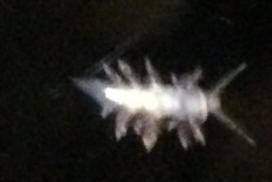 |
|
Don't think this is a medusa worm?
9/2/18
I have dry rock 2 inch sand bed tank is 4 months old 160 gal. 30 gal fuge
skimmer 10 gal Chaeto tumbler. I suddenly have these worms. I'm sure it was a
hitch hike off Chaeto. No one can tell me good or bad (. Please help before I
have hundreds of them.
<Does look like one. In which case, is more related to sea cucumbers
than to sea worms; these are generally peaceful scavengers, I wouldn´t
worry as they pose no threat to aquarium inhabitants.>
Thanks in advance. Oh and what fish might
eat them? Copper banded butterfly maybe?
<If your tank is a fish only, you can try a Trigger fish, however If you have a
mixed invertebrate/reef tank, try using a trap with some bait like fresh shrimp
at night. My suggestion is to do this only if you see that they start to
multiply or if you don´t want them at all in your tank >
<Wilberth>
|
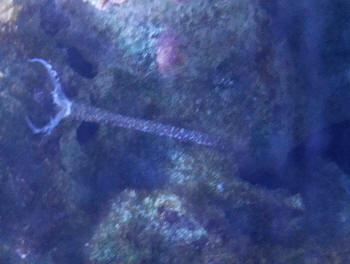
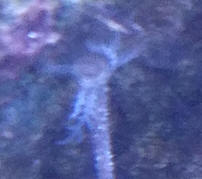 |
|
Re: Don't think this is a medusa worm?
9/2/18
Thanks! Very much. Happy reefing
<You´re very welcome, nice weekend. Wilberth>
|
|
ID... Marine? Terrestrial?
8/15/18
Hello,
<Ron>
And thanks for any help you can provide.
<Let's see...>
I do some collecting for my aquarium when I snorkel in the Florida Keys. I found
this in 2' of water 100' of the edge of a small island on the Florida Bay side
of the Keys. It was in the bright sun on the surface of the seabed, not under a
rock. I thought it was a small green sponge as it was in a small group of other
sponges (purple, orange and brown). The others are obvious sponges, but this one
has no excurrent holes I can find, and even with a magnifying glass I don't see
any incurrent pores. I looked at a lot of sponges anyway and the only thing that
came close is a ball sponge. But there were no green ones. The ones with the
longest bumps or spines were way shorter than these. And they all seemed to come
from cooler or colder waters. This was found in 80+ degree water. That leads me
to assume it's an algae. But I've looked at hundreds of algae photos and found
nothing remotely similar to this. I forwarded the info to 2 marine biologists I
deal with at a local marine museum and they were stumped as well!
<I as well... >
It's slightly smaller than a golf ball. It's not hard or soft but firm, like a
very small cell sponge. But as I said, I see no excurrent or incurrent holes or
pores. The appendages or spines are stiff but not hard.
It does not move, but in just a day or two it has attached to a rock. It is
currently sitting next to, almost on, a small rock flower anemone. Neither seems
to mind being in contact with the other.
<Am thinking this is a terrestrial fruit or seed of some sort; summat like a
drowned soursop. I'd be looking along the shoreline for more>
Thanks in advance for any help you can provide. Even if it's just leads to other
places to look or other people to ask. I want to put it in my display tank, but
I'm concerned it may go 'sexual' like Caulerpa algae and nuke my tank or spread
all over the tank.
<I'd be careful... not keep this in a prized setting>
Regards,
Ron Lindensmith
<Do me/us a favor and cut one open along the median and send a pic. Bob Fenner>
|
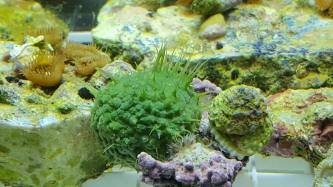
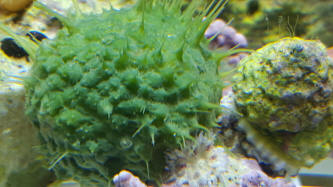 |
|
Re: ID 8/16/18
Hello Bob,
The idea that it could be terrestrial never entered my mind, or anybody else's
that has been involved in the ID process so far. So A+ for thinking outside the
box. And thanks for sharing that idea. I'll certainly pursue it more. But I
don't want to cut open the only specimen I have just yet.
<Okay; and have shared amongst friends, on Facebook!>
We were just off Little Money Key (Florida Bay side at the SW end of the Seven
Mile Bridge) which was virtually stripped clean of 95% of it vegetation 11
months earlier and still looks quite desolate except for a small amount of green
along 10% of the island on the side where we found this.
<Ahh! >
Would you assume the green is some kind of algae growing on the fruit or seed
pod?
<Nah; am more inclined to try scraping a bit off and looking under a few hundred
power 'scope>
The green is still alive as the 'spikes' or 'tendrils' are growing small spheres
at their tips and the spheres have tiny spikes sticking out of them. No many
terrestrial plants would germinate in saltwater.
<Well... there are some 53 families of embryophytes that have "gone back" to the
sea... considered "mangroves"... but again; I know naught>
Thank you for your incite and any further views would also be welcomed.
<Thank you Ron; for your continued sharing. BobF>
Regards,
Ron
Re: ID 8/16/18
Ron, howsit?
Marco Lichtenberger sent in a reply; and he (and I) think what you have is the
seed of a Platanus species of tree. Do see this genus, pix... sugar maple,
"monkey-ball" trees.
Perhaps P. hispanica or occidentalis for the location. Bob Fenner>
Re: ID 8/16/18
Bob, if I'm not mistaken, that is a very northern tree, and it's seed would end
up in the Florida Keys?
Ron
<Mmm; well, trees get moved about quite a bit. I would not be surprised to find
a Platanus member nearby the water, some place where the fruit could get into
the water and wash down to the sea. BobF>
Odd ID, green spiky ball 8/18/18
Bob I sent it to the sponge ID God at the nmnh, Dr Klaus Ruetzler for a look. I
don't know if he is still there or not but his email seems to work even though
he is Emeritus now. If not, I know Dr Allen Collins there. Allen is Curator of
jellyfish and the likes. They must still have a Sponge Curator there. He would
know.
that was really quick... Lol
"You are right, this is a sponge: Tethya actinia de Laubenfels, 1950, first
described from Bermuda. Both the orange and green varieties occur there
together. I’m not sure what causes the green color. I seem to remember to have
checked for algal/cyanobacterial symbionts but did not find any.
Klaus"
https://www.sealifebase.ca/summary/Tethya-actinia.html
<Thank you Boomer and Dr. K, BobF>
|
|
Id if possible. 7/13/18
Hi,
<Hi Adam>
I found a clear jelly like substance with the consistency like gummy bears.
It appears to have orange spheres within it.
Is it an egg or some form tunicate style organism.
<Appears to be some sort of harmless sea sponge>
I will be from Australian waters most likely great barrier reef or Perth western
Australian reefs. As we cannot import invertebrates.
Thanks in advance Adam
<Welcome. Wilberth>
|
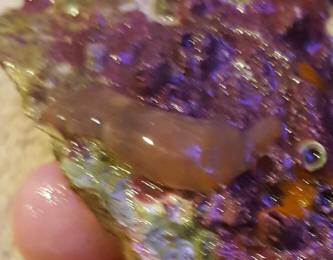 |
|
Re: Id if possible. 7/18/18
Hi Wet Web Media Crew/Wilberth
<Hi Adam,>
Is there any chance that was eggs as 4 days after going into the
aquarium the object has disappeared. <?>
<Could be; and if these are indeed eggs of some kind, you´ll find out on
the future, there’s a possibility that this is a species of sea squirt
in its reproductive stage.>
It was attached to a coco worm, which was very slowly acclimatised and
my system runs near sea water parameters for western Australia which is
where a lot of coral is collected from Australia.
Regards
<Greetings. Wilberth>
Adam Smith
|
|
Id of worm/potential young sea cucumber
6/13/18
Hi,
Got a frag of sps of a fellow reefer and found a couple of worm like creatures
that are very small on the bottom.
The guy i got the frags from has 2 cucumbers in his tank. To the best of his
knowledge no bobbit/eunice worms.
Wondering if you might be able to id or help out.
The large one in pictures is about 4mm long.
<Wow! No wonder your pix aren't cropped, crisp (highly resolved)... Likely are
Holothurians, but could be some type of worm. I wouldn't panic. Thanks for
sharing. Bob Fenner>
|
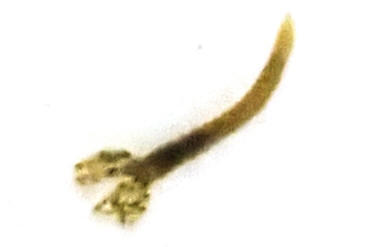 |
|
Re: Id of worm/potential young sea cucumber
6/13/18
Hi Bob,
Yes was very hard to get pics. Those were the best i could get.
So you would say safe to let loose in display?
<Yes; I would>
I figure if they are small holothurians the sand would be a benefit.
Adam
<Agreed. Cheers Adam. BobF>
|
|
Purple rolly poly creature 6/7/18
Hi Crew!
<Hi Dani>
Found this hitchhiker while I was aquascaping. It is less than a quarter of an
inch and resembles a roly poly bug.
<Ah yes, this is a mollusk of the class Polyplacophora, commonly known as Chiton
or sea cradle, they have shells made up of eight overlapping calcareous valves;
usually found on every environment, pose no threat to other aquarium inhabitants
as they are algae eaters, always crawling over the glass or rockwork grazing for
film algae and diatoms, so they can be use as part of the clean up crew.>
What I found most remarkable was his extremely bright purple color—like neon
bright kind of purple! I let him be in the tank. Figured I’d share, just in case
you haven’t come across this before, although you probably have lol.
<Thanks for sharing>
Sincerely, Dani Conner
<Wilberth.>
|
%20(1).jpeg) |
|
|

